Changing a Flat Tire*
If a tire goes flat while driving, grasp the steering wheel firmly, and brake gradually to reduce speed. Then, stop in a safe place. Replace the flat tire with a compact spare tire. Go to a dealer as soon as possible to have the full-size tire repaired or replaced.
- Park the vehicle on a firm, level, non-slippery surface and apply the parking brake.
- Put the transmission into P.
- Put the transmission into R.
- Turn on the hazard warning lights and set the power mode to VEHICLE OFF.
- Detail
-
Follow compact spare precautions:
Periodically check the tire pressure of the compact spare. It should be set to the specified pressure. Specified Pressure: 60 psi (420 kPa, 4.2 kgf/cm2)When driving with the compact spare tire, keep the vehicle speed under 50 mph (80 km/h). Replace with a full-size tire as soon as possible.The compact spare tire and wheel in your vehicle are specifically for this model. Do not use them with another vehicle. Do not use another type of compact spare tire or wheel with your vehicle.Do not mount tire chains on a compact spare tire.
If a chain-mounted front tire goes flat, remove one of the full-size rear tires and replace it with the compact spare tire. Remove the flat front tire and replace it with the full-size tire that was removed from the rear. Mount the tire chains on the front tire.NOTICE
Do not use the jack if it doesn’t work properly. Call your dealer or a professional towing service.
Manual transmission modelsDo not mount the compact spare on the front. If mounted on the front, the compact spare, smaller in size than the full-size tire, may damage the differential.
If either front tire goes flat, remove the rear tire on the same side, and mount the compact spare on the rear and the rear tire on the front.
Getting Ready to Replace the Flat Tire
-
- Pull the strap on the floor lid and open the lid.
-

-
- Take the tool case out of the trunk.
- Take the jack, wheel nut wrench, and jack handle bar out of the tool case.
- Unscrew the wing bolt, and remove the spacer cone. Then, remove the spare tire.
-

-
- Place a wheel block or rock in front and rear of the wheel diagonal to the flat tire.
-
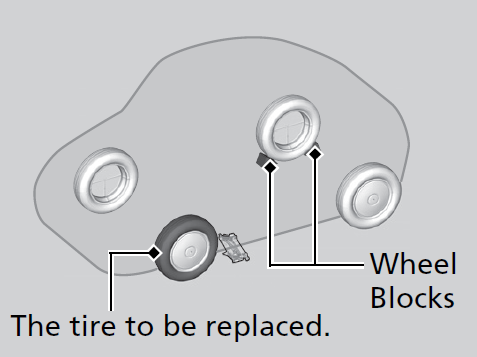
-
- Place the compact spare tire (wheel side up) under the vehicle body, near the tire that needs to be replaced.
-
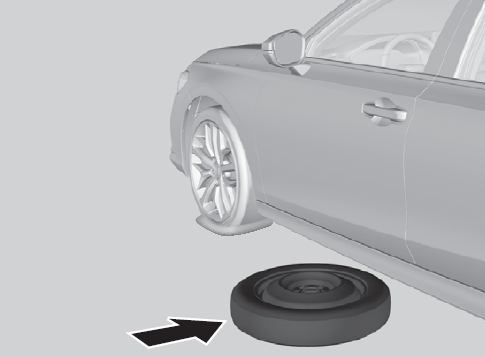
-
Models with wheel cover
- Put the flat tip of the jack handle bar into the edge of the wheel cover. Carefully pry the edge and remove the cover.
- Wrap a cloth around the flat tip of the jack handle bar to prevent scratches on the cover.
- Put the flat tip of the jack handle bar into the edge of the wheel cover. Carefully pry the edge and remove the cover.
-
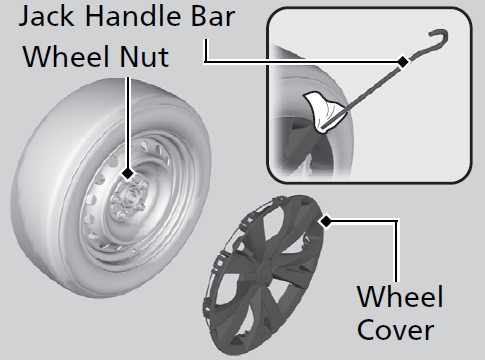
-
All models
- Loosen each wheel nut about one turn using the wheel nut wrench.
-
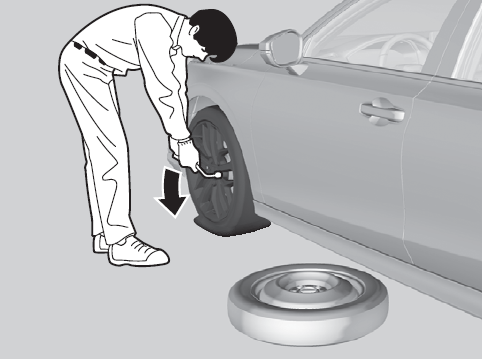
How to Set Up the Jack
-
- Place the jack under the jacking point closest to the tire to be changed.
-
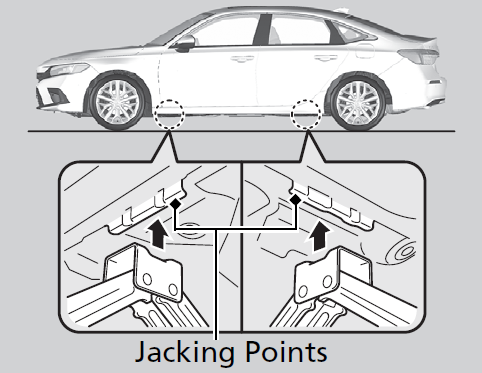
-
- Turn the end bracket clockwise as shown in the image until the top of the jack contacts the jacking point.
- Make sure that the jacking point tab is resting in the jack notch.
- Turn the end bracket clockwise as shown in the image until the top of the jack contacts the jacking point.
-
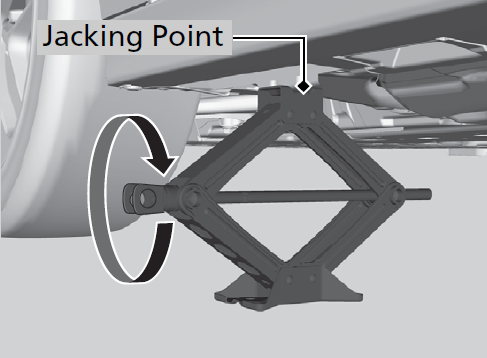
-
- Raise the vehicle, using the jack handle bar and the jack handle, until the tire is off the ground.
-
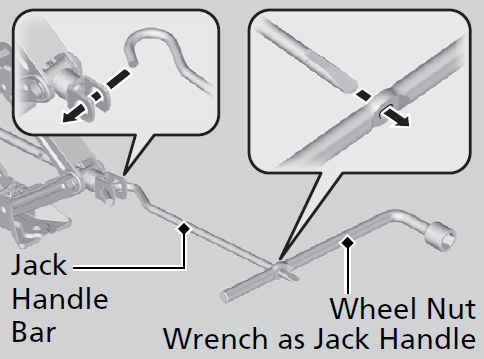
- WARNING
- The vehicle can easily roll off the jack, seriously injuring anyone underneath.
Follow the directions for changing a tire exactly, and never get under the vehicle when it is supported only by the jack.
- Detail
-
Do not use the jack with people or luggage in the vehicle.Use the jack provided in your vehicle.
Other jacks may not support the weight (“load”) or may not fit the jacking point.
The following instructions must be followed to use the jack safely:- Do not use while the engine is running.
- Use only where the ground is firm and level.
- Use only at the jacking points.
- Do not get in the vehicle while using the jack.
- Do not put anything on top of or underneath the jack.
Replacing the Flat Tire
-
- Remove the wheel nuts and flat tire.
-
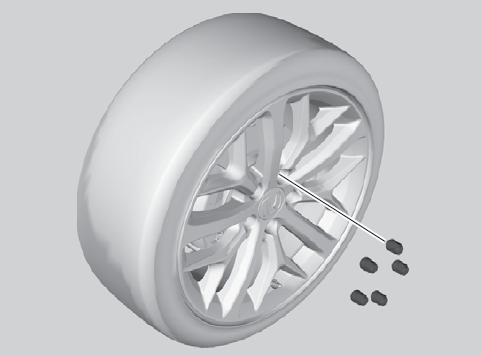
-
- Wipe the mounting surfaces of the wheel with a clean cloth.
- Mount the compact spare tire.
- Screw the wheel nuts until they touch the lips around the mounting holes, then stop rotating.
-
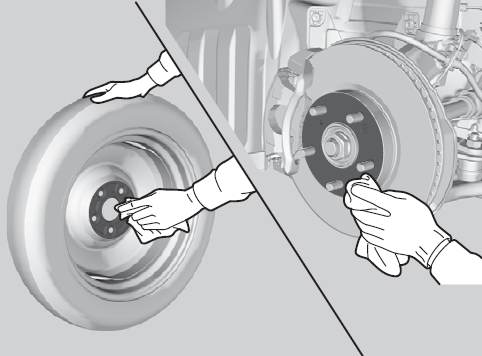
-
- Lower the vehicle and remove the jack. Tighten the wheel nuts in the order indicated in the image. Go around, tightening the nuts, two to three times in this order.Wheel nut torque:80 lbf∙ft (108 N∙m, 11 kgf∙m)
- Lower the vehicle and remove the jack. Tighten the wheel nuts in the order indicated in the image. Go around, tightening the nuts, two to three times in this order.
-
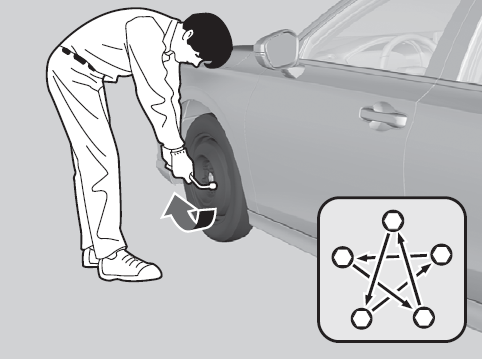
- Detail
-
Do not over tighten the wheel nuts by applying extra torque using your foot or a pipe.Models with wheel coverMake sure the wire support ring is hooked into the clips around the edge of the wheel cover.
Align the valve mark on the wheel cover to the tire valve on the wheel, then install the wheel cover.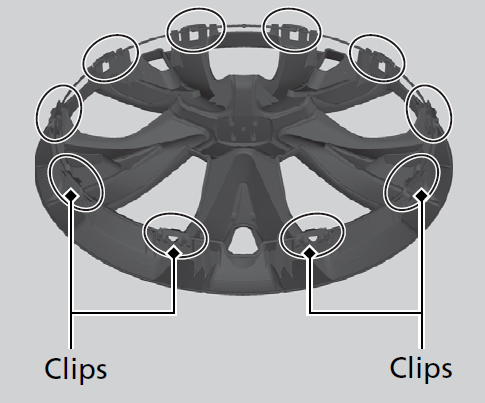
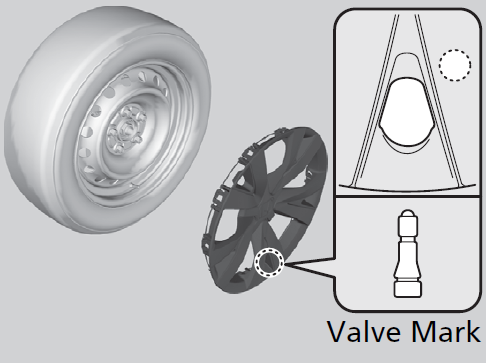 Models with wheel coverMake sure the wire support ring is on the outer side of the tire valve as shown.
Models with wheel coverMake sure the wire support ring is on the outer side of the tire valve as shown.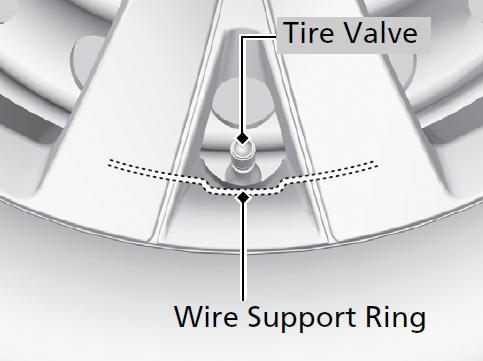
Storing the Flat Tire
-
Models with aluminum wheels
- Remove the center cap.
-
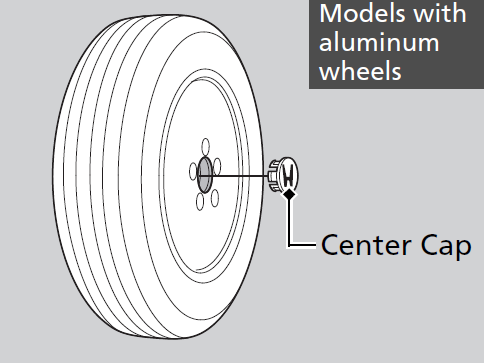
-
All models
- Place the flat tire face down in the spare tire well.
- Remove the spacer cone from the wing bolt, flip it over, and insert it back on the bolt. Secure the flat tire with the wing bolt.
- Securely store the jack, wheel nut wrench, and jack handle bar back in the tool case. Store the case in the trunk.
-

- WARNING
- Loose items can fly around the interior in a crash and can seriously injure the occupants.
Store the wheel, jack, and tools securely before driving.
TPMS and the Compact Spare Tire
If you replace a flat tire with the spare tire, the low tire pressure/TPMS indicator comes on while you are driving. After driving for a few miles (kilometers), Tire pressure monitor system problem. Check tire pressure. See your dealer. will appear on the driver information interface and the indicator will start blinking for a short time and then stay on; however, this is normal and is no cause for concern.
Calibrate the TPMS when you replace the tire with a specified regular tire.
* Not available on all models
Temporarily Repairing a Flat Tire*
If the tire has a large cut or is otherwise severely damaged, you will need to have the vehicle towed. If the tire only has a small puncture, from a nail for instance, you can use the temporary tire repair kit so that you can drive to the nearest service station for a more permanent repair.
If a tire goes flat while driving, grasp the steering wheel firmly, and brake gradually to reduce speed. Then, stop in a safe place.
- Park the vehicle on a firm, level, non-slippery surface and apply the parking brake.
- Put the transmission into R.
- Turn on the hazard warning lights and set the power mode to VEHICLE OFF.
- Detail
-
The kit should not be used in the following situations. Instead, contact a dealer or roadside assistance to have the vehicle towed.
- The tire sealant has expired.
- More than one tire is punctured.
- The puncture or cut is larger than 5/32 inch (4 mm).
- The tire side wall is damaged or the puncture is outside the contact area.
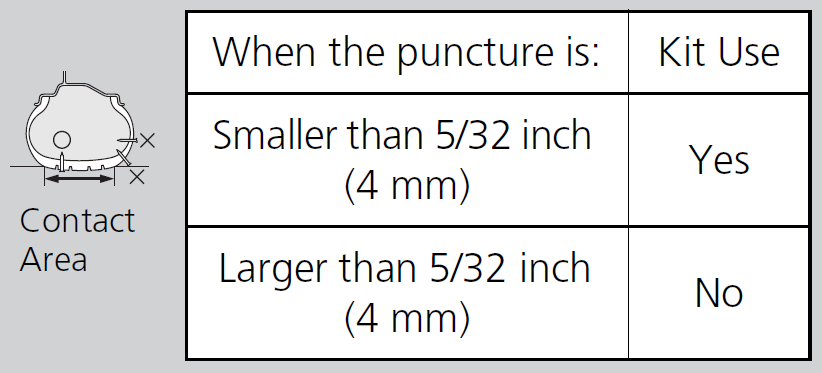
- Damage has been caused by driving with the tire extremely under inflated.
- The tire bead is no longer seated.
- The rim is damaged.
Do not remove a nail or screw that punctured the tire. If you remove it from the tire, you may not be able to repair the puncture using the kit.
Getting Ready to Temporarily Repair the Flat Tire
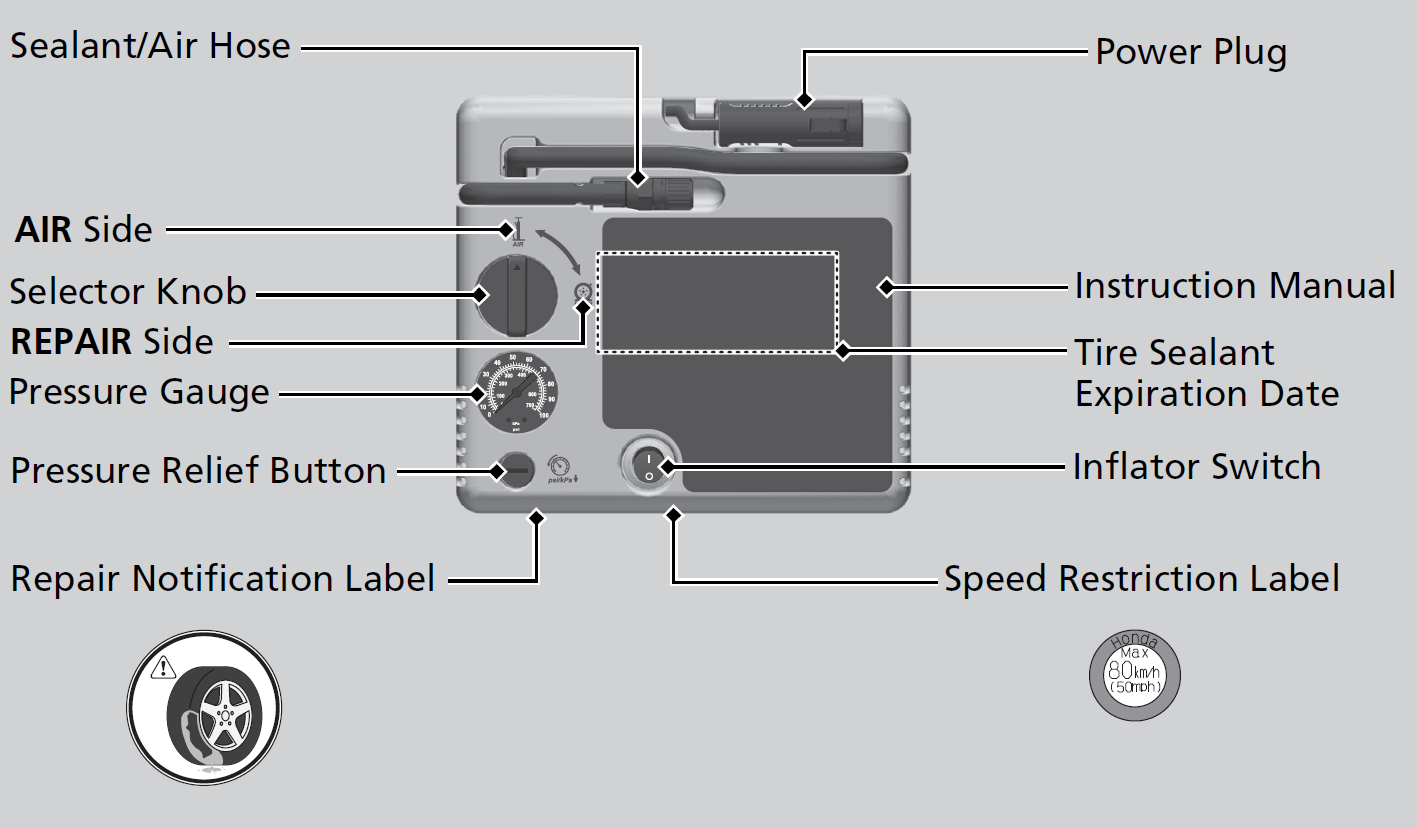
-
- Pull the strap on the floor lid and open the lid.
-
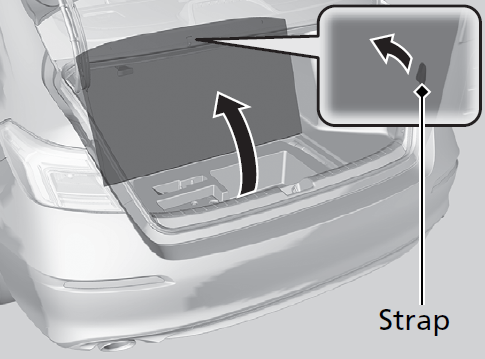
-
- Take the kit out of the case.
- Place the kit face up, on flat ground near the flat tire, and away from traffic. Do not place the kit on its side.
-
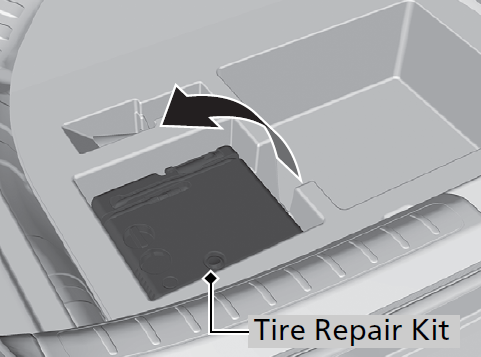
- Detail
-
Repair notification label and speed restriction label are applied to the side of the temporary tire repair kit.When making a temporary repair, carefully read the instruction manual provided with the kit.
Injecting Sealant and Air
-
- Remove the valve cap from the tire valve stem.
-
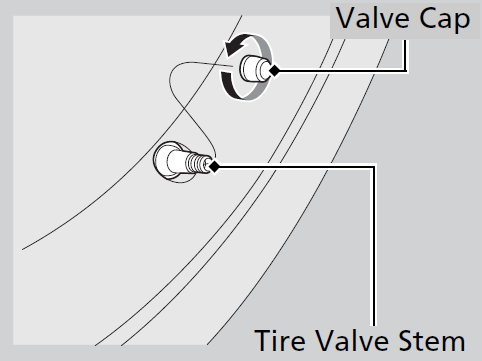
-
- Remove the sealant/air hose from the packaging.
-
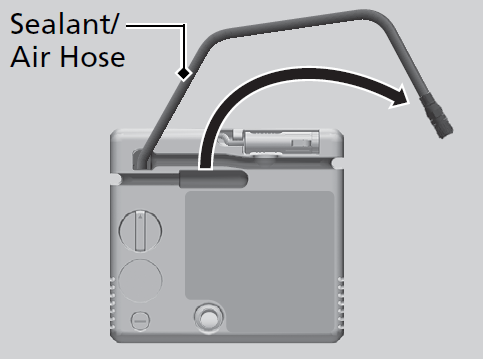
-
- Attach the sealant/air hose onto the tire valve stem. Screw it until it is tight.
-
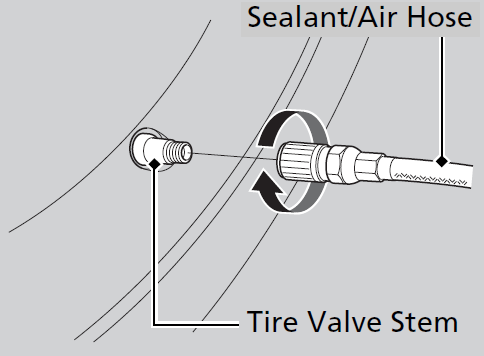
-
- Plug in the compressor to the accessory power socket.
- Be careful not to pinch the cord in a door or window.
- Start the engine.
- Keep the engine running while injecting sealant and air.
- Plug in the compressor to the accessory power socket.
-

-
- Turn the selector knob to REPAIR.
-
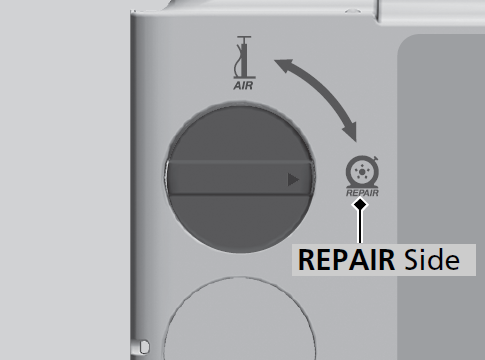
-
- Press the inflator switch to turn on the kit.
- The compressor starts injecting sealant and air into the tire.
- When the sealant injection is complete continue to add air.
- After the air pressure reaches to specified pressure, turn off the kit.
- To check the pressure, occasionally turn off the compressor and read the gauge.
- Refer to the driver’s doorjamb label for the specified pressure.
- Press the inflator switch to turn on the kit.
-
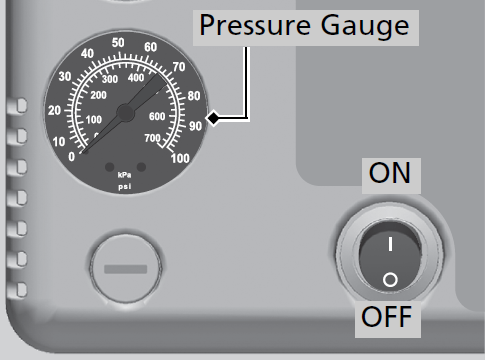
-
- Unplug the power plug from the accessory power socket.
- Unscrew the sealant/air hose from the tire valve stem. Reinstall the valve cap.
- Press the pressure relief button until the gauge returns to 0 psi (0 kPa).
-
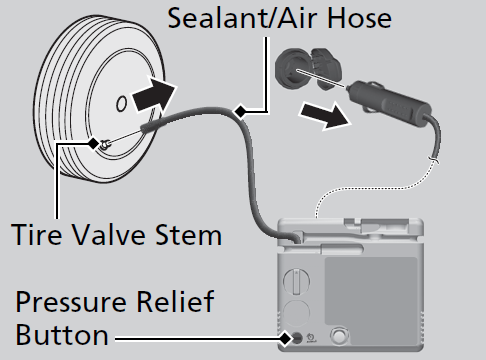
-
- Apply the repair notification label to the flat surface of the wheel.
- The wheel surface must be clean to ensure the label adheres properly.
- Apply the repair notification label to the flat surface of the wheel.
-
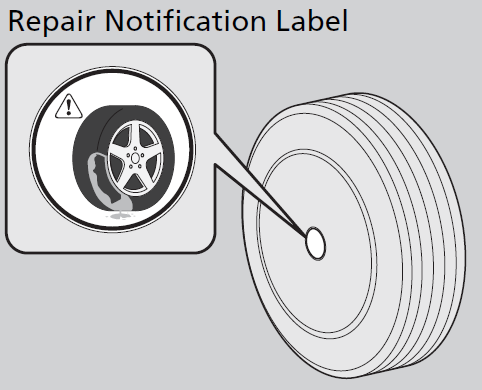
- CAUTION
- Tire sealant contains substances that are harmful if inhaled, ingested or if contact is made with the eyes or skin.
Always use in a well-ventilated area and use gloves and safety glasses for protection; do not ingest.
For skin or eye contact, flush with cool water; if ingested, rinse mouth with water. In all cases, seek medical attention if necessary.
- WARNING
- Running the engine with the vehicle in an enclosed or even partly enclosed area can cause a rapid buildup of toxic carbon monoxide.
Breathing this colorless, odorless gas can cause unconsciousness and even death. Only run the engine to power the air compressor with the vehicle outdoors.
- Detail
-
In cold temperatures, the sealant may not flow easily. In this situation, warm it up for five minutes before using.The sealant can permanently stain clothing and other materials. Be careful during handling and wipe away any spills immediately.
NOTICE
Do not operate the temporary tire repair kit compressor for more than 15 minutes. The compressor can overheat and become permanently damaged.
Until the sealant injection is complete, the pressure shown on the pressure gauge will appear higher than actual. After the sealant injection is complete the pressure will drop and then begin to rise again as the tire is inflated with air. This is normal. To accurately measure the air pressure using the gauge, turn the air compressor off only after the sealant injection is complete.If the required air pressure is not reached within 10 minutes, the tire may be too severely damaged for the kit to provide the necessary seal, and your vehicle will need to be towed.See a dealer for a replacement sealant bottle and proper disposal of an empty bottle.
Distributing the Sealant in the Tire
-
- Apply the speed restriction label to the location as shown.
- Drive the vehicle for about 10 minutes.
- Do not exceed 50 mph (80 km/h).
- Stop the vehicle in a safe place.
-
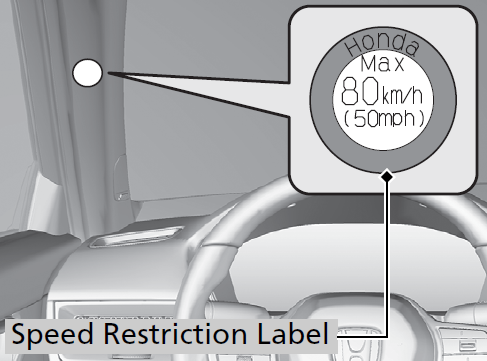
-
- Recheck the air pressure using the sealant/air hose on the compressor.
-
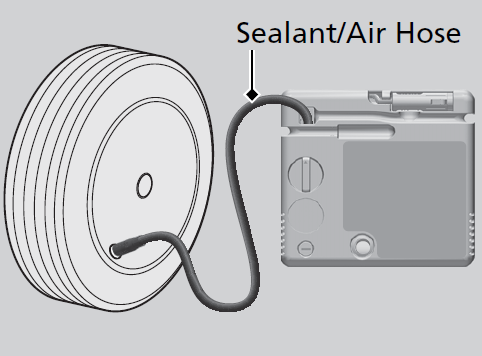
-
- Turn the selector knob to AIR.
- Do not turn the air compressor on to check the pressure.
- Turn the selector knob to AIR.
-

- If the air pressure is
- Less than 19 psi (130 kPa):
- Front: 33 psi (225 kPa)/rear: 32 psi (220 kPa) or more:
- If the air pressure does not go down after the 10 minute driving, you do not need to check the pressure any more.
- Greater than 19 psi (130 kPa), but less than front: 33 psi (225 kPa)/rear: 32 psi (220 kPa):
Inflating an Under-inflated Tire
Then, drive carefully for 10 more minutes or until you reach the nearest service station, whichever is sooner. Do not exceed 50 mph (80 km/h). If you have not reached a service station, stop and check the tire pressure.- You should repeat this procedure as long as the air pressure is within this range.
-
- Unplug the kit from the accessory power socket.
- Unscrew the sealant/air hose from the tire valve stem. Reinstall the valve cap.
- Press the pressure relief button until the gauge returns to 0 psi (0 kPa).
- Repackage and properly stow the kit.
-
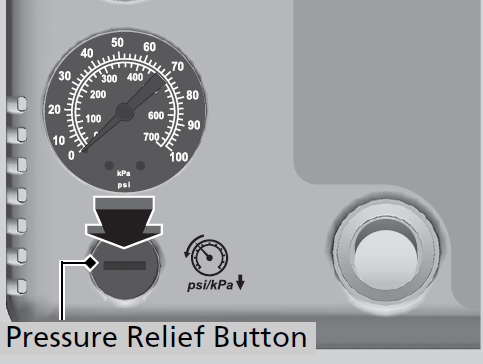
- WARNING
- Running the engine with the vehicle in an enclosed or even partly enclosed area can cause a rapid buildup of toxic carbon monoxide.
Breathing this colorless, odorless gas can cause unconsciousness and even death. Only run the engine to power the air compressor with the vehicle outdoors.
Inflating an Under-inflated Tire
You can use the kit to inflate a non-punctured under-inflated tire.
-
- Open the trunk floor lid.
- Remove the kit from the case.
- Place the kit, face up, on flat ground near the tire to be inflated, away from traffic. Do not place the kit on its side.
- Remove the sealant/air hose from the kit.
-
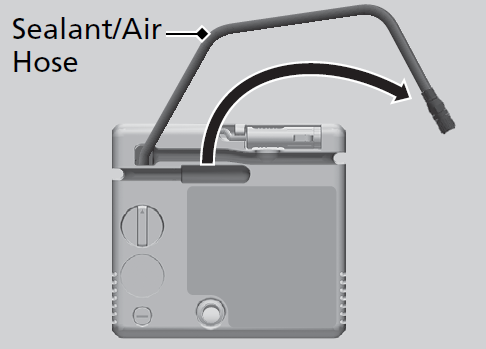
-
- Remove the valve cap.
-

-
- Attach the sealant/air hose onto the tire valve stem. Screw it until it is tight.
-

-
- Plug in the kit to the accessory power socket.
- Be careful not to pinch the cord in a door or window.
- Start the engine.
- Keep the engine running while injecting air.
- Plug in the kit to the accessory power socket.
-

-
- Turn the selector knob to AIR.
- Press the inflator switch to turn on the kit.
- The compressor starts to inject air into the tire.
- Inflate the tire to the specified air pressure.
-
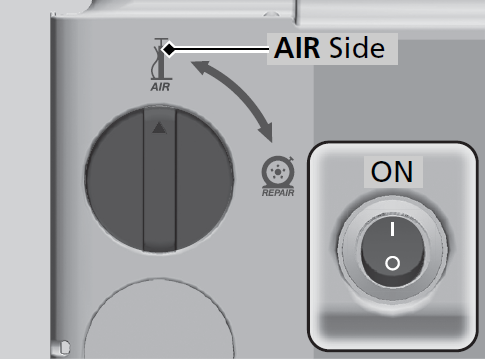
-
- Turn off the kit.
- Check the pressure gauge on the air compressor.
- If overinflated, press the pressure relief button.
- Unplug the kit from the accessory power socket.
- Unscrew the sealant/air hose from the tire valve stem. Reinstall the valve cap.
- Press the pressure relief button until the gauge returns to 0 psi (0 kPa).
- Repackage and properly stow the kit.
- Turn off the kit.
-

- WARNING
- Running the engine with the vehicle in an enclosed or even partly enclosed area can cause a rapid buildup of toxic carbon monoxide.
Breathing this colorless, odorless gas can cause unconsciousness and even death. Only run the engine to power the air compressor with the vehicle outdoors.
- Detail
-
NOTICE
Do not operate the temporary tire repair kit compressor for more than 15 minutes. The compressor can overheat and become permanently damaged.
* Not available on all models
- Recommended topic(s)
